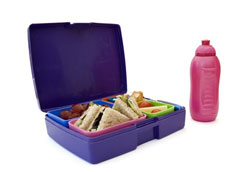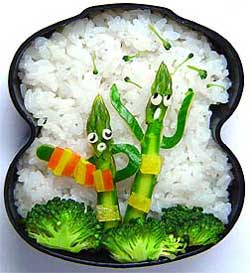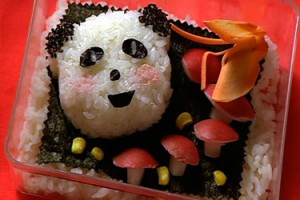Obento: The Japanese Art of Box Lunches
by Sara Fujimura
Look into the school cafeteria’s trash can. What do you see? Crusts from peanut butter and jelly sandwiches, half-eaten apples, and plastic. Tons and tons of plastic. In fact, according to the New York State Department of Environmental Conservation, the average school-aged child who brings a disposable lunch generates about 4-8 ounces of garbage every day. That’s 45-90 pounds of garbage per year! For an average-sized elementary school, that’s 18,760 pounds (almost 10 tons) of lunch waste! Single-serving foods are super convenient for today’s busy parents, but at what cost? Start showing Mother Earth a little respect and pack your children obento, American-style.
Obento, or boxed meal, is an art form in Japan. Japanese mothers spend an enormous amount of time and energy constructing the perfect obento—balancing taste, color, and texture. In fact, there are monthly magazines devoted solely toobento making. Readers learn how to magically transform rice into popular cartoon characters. Or how to make carrot roses, apple-slice bunnies, and other miniature works of edible art. Another reason for obento boxes: They cut down on waste. Japan has some of the strictest garbage/recycling rules in the world. Japanese children routinely carry to school a plastic obento box, a pair of chopsticks, a thermos, and a cotton napkin. Nearly zero waste! Just think if your child’s classroom did the same.
Unfortunately, I don’t know of any American parents with an hour to devote to lunch making. So, taking a Japanese idea and giving it a good ole American twist, I’’ve come up with three healthy, ecologically-sound, kid-pleasing obento ideas that can be made in 10 minutes or less. But first a couple of tips:
Start with the right containers  Use food-grade containers only, as one-time-use plastic containers may leach harmful chemicals into food. There is an obento box for any budget. [See below]. The point is to pick something that your child likes, will fit into their lunch bag/back pack, is easy to wash, and is divided enough to keep juicy foods from oozing all over your sandwich. Or, buy a set of smaller containers to keep them completely separate.
Use food-grade containers only, as one-time-use plastic containers may leach harmful chemicals into food. There is an obento box for any budget. [See below]. The point is to pick something that your child likes, will fit into their lunch bag/back pack, is easy to wash, and is divided enough to keep juicy foods from oozing all over your sandwich. Or, buy a set of smaller containers to keep them completely separate.
It’s all about presentation  Take a tip from four-star restaurants: Presentation makes things more palatable. Not that you have to spend hours cutting out carrot roses, but be conscious of mixing colors, textures, and taste. For example, peanut butter on wheat bread with graham crackers and raisins. BORING! Try adding some cherry tomatoes or kiwi slices on the side to liven up your child’s lunch and give it a nutritional punch at the same time.
Take a tip from four-star restaurants: Presentation makes things more palatable. Not that you have to spend hours cutting out carrot roses, but be conscious of mixing colors, textures, and taste. For example, peanut butter on wheat bread with graham crackers and raisins. BORING! Try adding some cherry tomatoes or kiwi slices on the side to liven up your child’s lunch and give it a nutritional punch at the same time.
Doing double duty
Stop reinventing the wheel. Make lunches as you are making dinner. Cutting up carrots for a dinner salad? Place a few extra pieces to the side to pop into your child’s lunch. Making (or buying) sushi for dinner? Make a few extra with a different topping. Spoon out a helping of pasta before putting on the marinara sauce and turn it into easy pasta salad.
Cheat, if you have to
Feeling guilty about your child’s lunch but think you are too time-pressed to improve it? Cheat. Go ahead and pay a little more for convenien t—but still healthy —foods such as baby carrots, grape tomatoes, prewashed baby spinach, cans of pineapple tidbits or mandarin oranges.
Show some team spirit!
Get other family members involved. Let older children make their own lunches while you make dinner. As long as they construct a healthy, balanced meal, who cares if their combinations are strange. You don’t have to eat it. Review your school’s lunch policy. My children’s school is very strict about junk foods in lunches, so that ends a lot of battles right there. Try to keep your pantries stocked with a variety of healthy foods to choose from, and your kids will make healthier choices. Ask your kids what they like and try to be accommodating. Take the kids food shopping with you and ask them to pick out lunch choices. I know: “It’s easier if I just do it myself.” Easier? Maybe. But with obesity and type-2 diabetes dramatically rising in both adults and children, investing time in “teachable moments” like these could pay off in a lifetime of healthy eating habits.
Seeing the bigger picture
Don’t forget Mother Earth. All that plastic has to go somewhere. Brainstorm at home about ways your family can cut down. We can break America’s “throw-away society” mentality, one family at a time. Let’s do it voluntarily before—like Japan—it becomes mandatory.
There is an obento system for every budget.
- Sandwich and snack-sized plastic containers can be bought inexpensively at grocery stores and any mass retailer.
- Traditional obento systems can be bought at your local Asian food specialty store and at Sanrio™ stores (the “Hello Kitty” people).
Here are three easy lunches you can prepare in 10 minutes or less. Pair them with a thermos of soy milk, 100% fruit juice, or water to round out the healthy meal.
PB&J sandwich, crust off, cut into quarters
Carrot sticks
Green grapesHummus with a little cumin sprinkled on top
Whole wheat pita, cut into wedges
Cucumber and/or green pepper slices
Strawberries4-6 Homemade or store bought Inari or other sushi rolls *
Large orange-kiwi-pineapple fruit salad
Still don’t think you can commit to obento yet? That’s okay. Like any new habit, start small and build. This week, ditch the juice boxes and let your child choose out a new thermos. Next week, ditch the single-serving fruit cups. Slowly work your way to a trash-free lunch.
You can do it. Your kids— and Mother Earth—will thank you.


